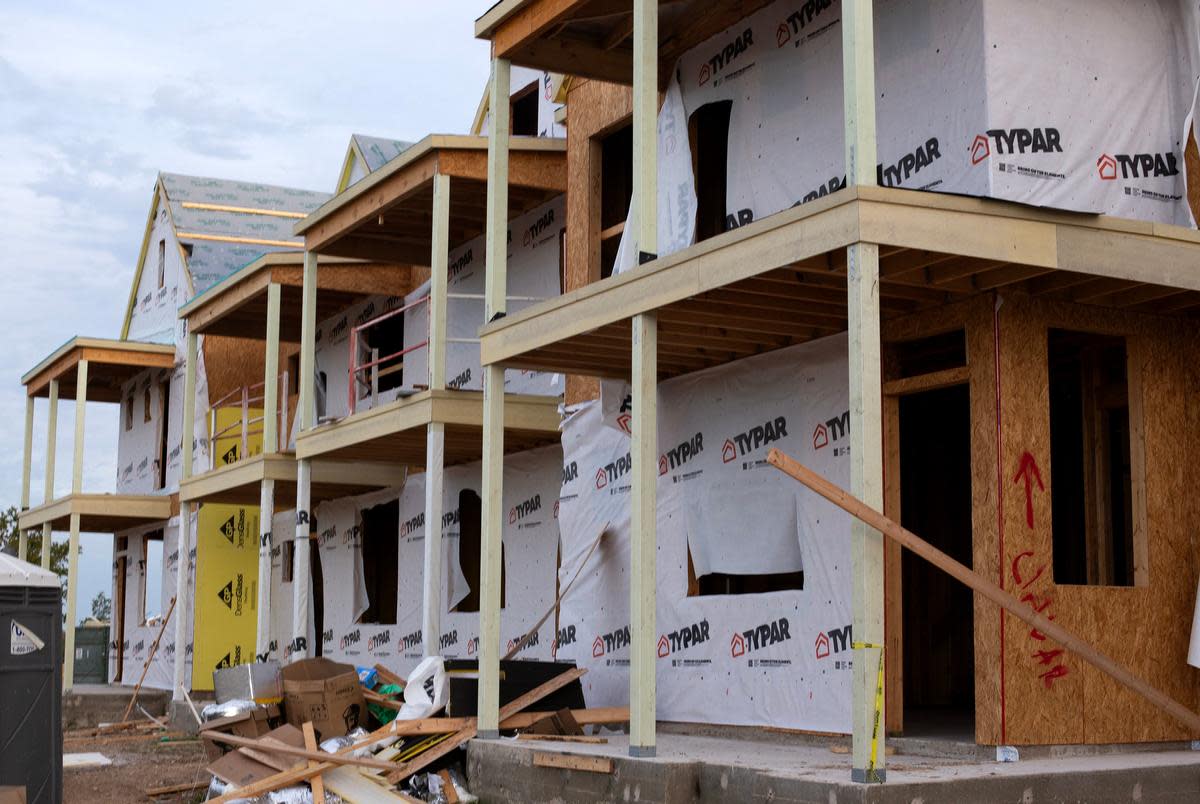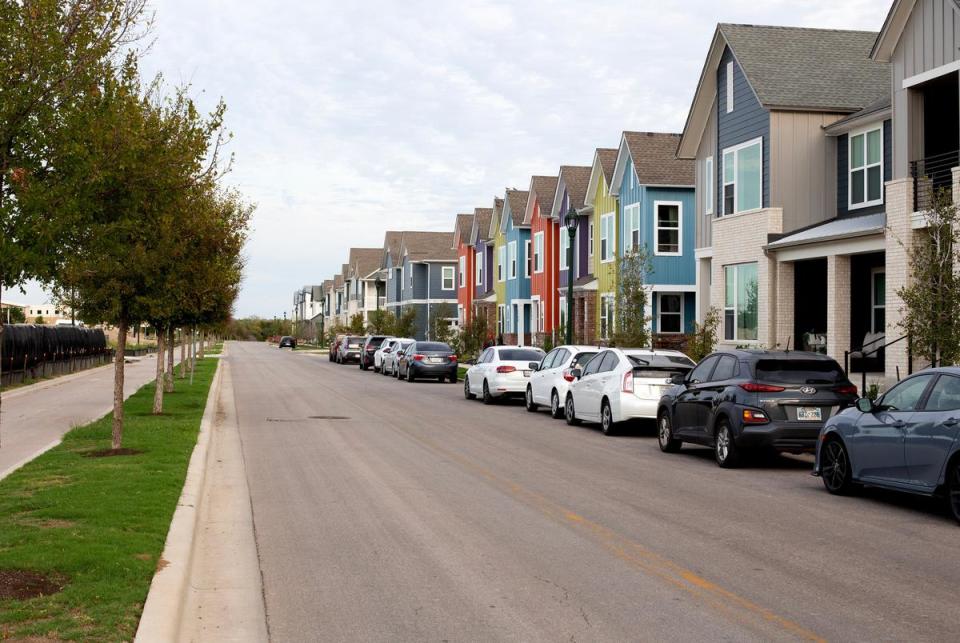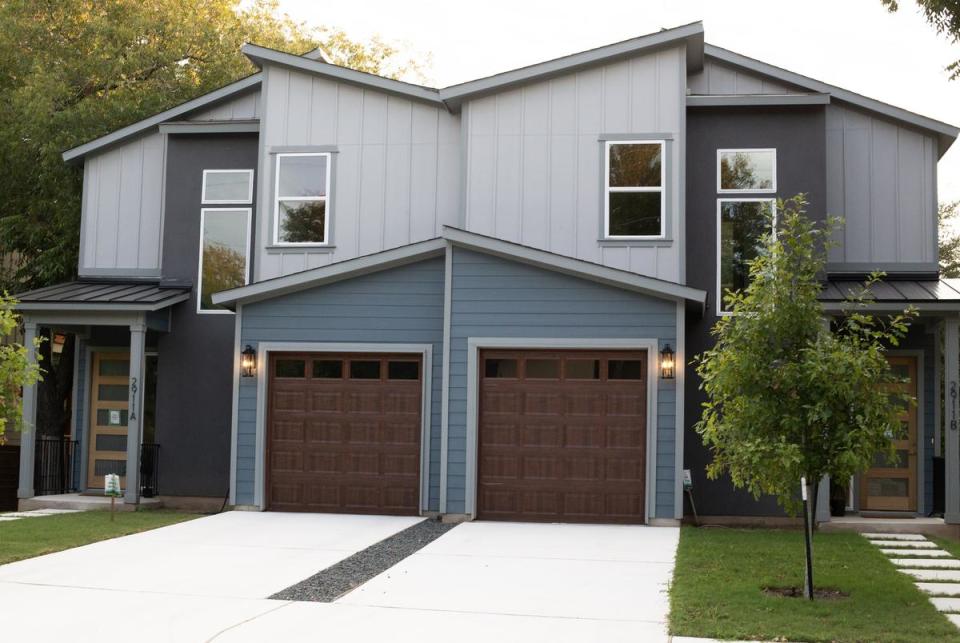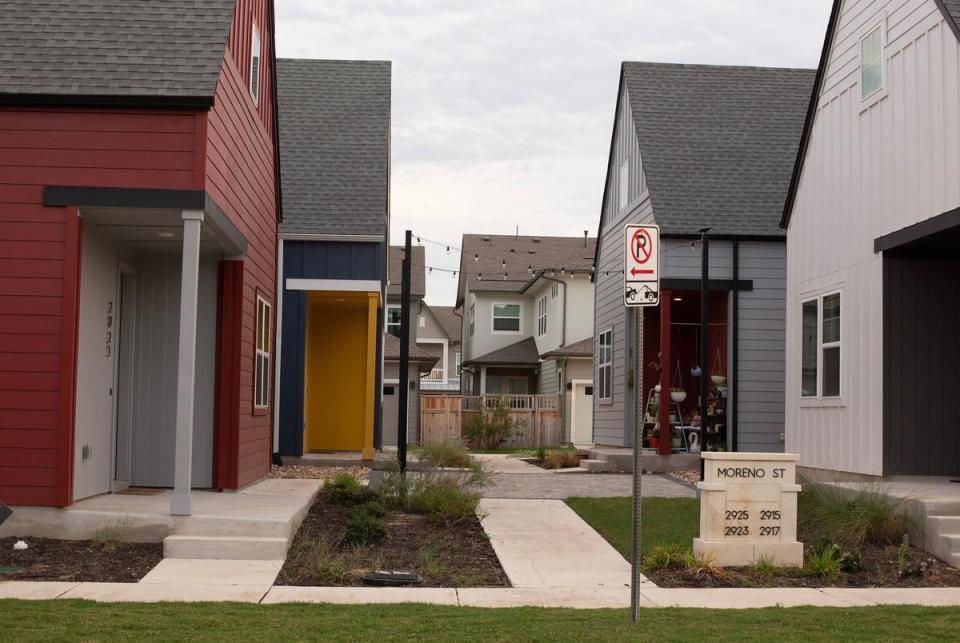As Texans struggle with housing costs, cities look for new ways to spur more home construction

DALLAS — Home prices are out of reach for first-time homebuyers. Sky-high rents are squeezing tenants. As the state’s housing affordability crisis escalates, leaders of Texas’ biggest cities are increasingly reaching the same conclusion: Their cities need more homes.
Texas home prices and rents hit record highs in recent years as the state’s economy boomed, millions of people moved here and millennials entered the homebuying market in full force. But the number of homes in the state hasn’t kept pace with the crushing demand spurred by the rapid growth — a key culprit, experts say, in what drove housing costs sky high.
Local leaders are increasingly open about the fact that their cities need to build more housing — or else few people will eventually be able to afford to live there.
“If you increase the supply of housing, you will push down the price, because there's more of it,” Dallas Mayor Eric Johnson said last month during a Texas Tribune Festival panel. “Therefore, it's less scarce and, therefore, people can't charge as much for it. … That's going to be a challenge for us: to make sure that Dallas doesn't become unaffordable for folks in the middle- and lower-income strata because it is becoming a more desirable place.”
From Austin to Fort Worth, local officials are eyeing proposals to blunt their city’s rampant unaffordability by loosening local regulations that housing advocates say get in the way of allowing more homes to be built. It’s a solution increasingly embraced by local and state policymakers across the country, and even the most recent three presidential administrations, as a key step, though not the only one, to solving the nation’s housing affordability crisis.
A crucial part of the equation: Texas cities are dominated by single-family neighborhoods. That’s a product of how cities developed over the course of the 20th century and a cultural attachment to having one home per large lot. In several major Texas cities, much of the land set aside for residential construction can only be used for single-family homes.

Any push to allow denser housing in traditional single-family neighborhoods will undoubtedly encounter stiff and vocal opposition from homeowners and neighborhood groups, who often complain that such housing construction would disrupt their neighborhood’s character. In 2020, for instance, a group of Austin homeowners successfully killed a push by city officials to relax zoning restrictions. They now want to end a set of city housing reforms that encourage denser housing, including a successful affordable housing program.
There’s plenty of skepticism that allowing the market to add more homes could blunt rising housing costs and fears that it would fuel gentrification and displacement in low-income communities, though research shows such reforms may protect those communities. Critics also believe such attempts would do little more than boost developers’ profits.
"Amnesia has allowed some creative profiteers to rebrand trickle-down policies as a housing solution," said Carmen Llanes Pulido, executive director of Go Austin/Vamos Austin, a community health coalition. "And half of progressive Austin is hoodwinked."
But city policymakers have begun to realize the decades-long devotion to the traditional single-family home at the expense of other housing options is coming back to bite them as their regions struggle to absorb the extraordinary demand for housing their cities have seen over the past several years.
“If we want to provide housing for our teachers, our health care workers, our postmen, our firefighters and police, if we want them in our cities, which I think we do, then we have to rethink the definition of single-family neighborhoods,” Dallas City Council member Chad West said.
Among the ideas: reducing the amount of land that cities require homes to sit on and allowing different kinds of housing — like duplexes and fourplexes — to be built in single-family neighborhoods. Cities are exploring — and pushing — ways to allow developers to build a broader swath of housing between a typical single-family home and a blocky apartment complex. Doing so, proponents and housing experts say, would allow more homes to hit the market. They say that would moderate housing costs — giving would-be first-time buyers a better shot at homeownership and tenants relief on their monthly rent.
“There is no one single perfect solution to housing affordability, and as our city continues to grow I am focused on ensuring we have that right mix of strategies that have long-term impact," Fort Worth Mayor Mattie Parker said.
The “missing middle”
Home prices in Texas’ largest metro areas rose so much in the last several years that the typical for-sale home is out-of-reach for most families living there, according to figures from the National Association of Home Builders.
And as rents surged during the pandemic, more tenants had a tougher time paying for other necessities. Roughly half of renters in the state’s major urban areas spend more than 30% of their income on keeping a roof over their heads, according to the Joint Center for Housing Studies at Harvard University. These “cost-burdened” renters spend so much on housing that it’s crowding out other necessary household expenses like child care, groceries and transportation — and making it more difficult for renters to become homeowners.
“When you're having to overspend on rent, it becomes hard to save for homeownership, harder to save for a down payment and the other costs associated with buying a home,” said Ashley Flores, senior director at the Dallas nonprofit Child Poverty Action Lab.
One way cities are looking to beat back the affordability crisis is to allow more “missing middle” housing — a loose term that means housing like duplexes, fourplexes and small apartment buildings that fall between a single-family home and a mid-rise apartment building.
Texas builds a lot of single-family homes and larger apartment complexes, but not as much in between — even as housing permits during the pandemic era hit levels not seen since the 1980s. Permits for duplexes, triplexes and fourplexes, for example, steadily ticked up in the last decade, data from the Texas Real Estate Research Center at Texas A&M University show, but still only made up less than 3% of the state’s permitting activity from 2020 to 2022.

Officials in Austin, Dallas and Houston are trying to make it easier to build such housing in traditionally single-family neighborhoods without totally upsetting the character of those neighborhoods.
“The main outcome that they're trying to achieve is to create ownership housing that sells for a non-ridiculous amount that a normal person that you could relate to might think of being able to afford, but it still looks recognizably like a house,” said Jake Wegmann, an associate professor at the University of Texas at Austin’s School of Architecture who studies housing affordability. “It doesn't have to be like a radical departure from what the neighborhood looks like.”
In the epicenter of the state’s affordability crisis, Austin officials want to allow up to three housing units to be built nearly anywhere single-family homes are currently allowed. If the city allows more homes to be built on lots that currently only allow one home, proponents argue, the cost of the land would spread across multiple households, thus lowering the overall cost of the homes on that land.
Three hours north on Interstate 35, officials in Dallas and Fort Worth are trying to figure out how to allow more homes to be built amid high housing costs. Over the last decade, the Dallas-Fort Worth area emerged as an economic juggernaut and one of the nation’s fastest-growing metropolitan areas.
With that growth came higher housing costs. The typical home in Dallas-Fort Worth went for less than $300,000 in the months before the COVID-19 pandemic began, according to Texas A&M data. At the height of the state’s hot housing market last year, the median sales price soared more than 60% — growing past $400,000. The market has since cooled amid higher interest rates, but the median home price in the region is 50% higher than it was before the pandemic.
Renters, too, have felt the pinch. Typical rents in the Dallas-Fort Worth region are more than 30% higher than they were before the pandemic, Zillow data shows, hovering at $1,850 a month.
If left unchecked, the region’s high housing costs could imperil its economic growth.
“Fort Worth is the fastest-growing city in the country, and without affordable housing and paths to affordable homeownership we won’t be able to support the skilled workforce that we need to thrive,” Parker, that city’s mayor, said. “Our rapid growth shows no sign of slowing down, so we’re looking at solutions we can start implementing now to meet those growing housing needs.”
One reason for the run-up in costs, housing advocates and real estate experts say, is that the Dallas-Fort Worth region hasn’t built enough homes to keep up with its job growth. Homebuilding plummeted across the country in the years after the housing crash of 2008, and Dallas-Fort Worth was no exception. In Dallas, there were about as many housing units built in the 2010s as in the 2000s, despite 10 times more population growth than in the previous decade, a recent Child Poverty Action Lab found.
“Construction took such a hit in the wake of the Great Recession that we've been playing from behind for the last 10 years,” Flores said.
That pace of building has left the region with a dire shortage of housing that’s at least partially responsible for its higher home prices and rents, experts say. By one estimate, the Dallas-Fort Worth metro area needed more than 85,000 housing units than it had in 2019 — before the region added more than 200,000 households over the pandemic. Low-income renters feel the housing shortage most acutely as they compete with higher-income households for limited rental stock, Flores said.
Faced with a growing affordability crunch, Dallas could soon follow Austin’s lead in trying to get a grip on its housing shortage. West, who represents the northern part of Dallas’ Oak Cliff neighborhood, plans to unveil a proposal that would allow duplexes, triplexes and fourplexes anywhere in the city single-family homes are allowed. Allowing that kind of density is key to preventing the city from becoming completely unaffordable, West said.
“The simple law of economics is that if you have increased supply, you have stabilized or reduced prices,” West said. “If we don't want to become [the wealthy Dallas suburb] Highland Park across the entire city, we have got to embrace allowing a little bit more density.”
Thirty minutes west of Dallas, officials in Fort Worth have also broached the idea of encouraging more abundant housing. City officials there are exploring how to encourage developers to build housing with anywhere from four to 100 units — housing that’s technically allowed under Fort Worth’s zoning code.
“We're growing at a rate of 20,000 people a year approximately,” said D.J. Harrell, Fort Worth’s director of development services. “Eventually, we're going to need to come up with new housing solutions or the price of homes will continue to escalate.”
Even Houston, the most affordable large city in the country, is trying to allow more homes to be built as home prices and rents grow out of reach for its residents. In late September, the Houston City Council sought to allow more “missing middle” housing by loosening city restrictions to make it easier for developers to build three to eight housing units on a given lot. The council also voted to allow larger accessory dwelling units — also known as ADUs, garage apartments or “granny flats” — in the backyards of single-family homes. They also passed rules designed to promote developments in which smaller single-family homes surround a shared courtyard.
“It increases the opportunity to develop properties in different ways and provides a variety of housing options at different price points and makes housing more economical for people at different income levels,” said Suvidha Bandi, principal planner at Houston’s planning and development department.
Smaller lots, more homes
Allowing more “missing middle” housing isn’t the only potential reform on deck. Policymakers in Austin and Dallas also are weighing whether to reduce their cities’ minimum lot sizes for single-family homes — the amount of land the cities require those homes to sit on.
A proposal carried by Austin City Council member Leslie Pool would reduce the minimum lot size in the city's three most common single-family zoning categories. The minimums for those tiers currently range from 5,750 square feet to nearly a quarter of an acre. Pool’s proposal would reduce the minimum for all three to 2,500 square feet. In Dallas, West would like to see the minimum lot size decreased to 1,500. The thinking goes that buying a home won’t be as expensive if homebuyers don’t have to purchase as much land along with it.
“When you are forcing people to use more land per housing unit, then you are necessarily increasing the cost per housing unit,” said Adam Perdue, a research economist at the Texas Real Estate Research Center at Texas A&M University.

Lowering the minimum lot size would enable more homes to be built on less land, real estate experts and housing advocates say. In Dallas, for example, it’s common for a home to sit on 7,500 square feet of land because of city requirements. Reducing the minimum lot size under West’s proposal would allow more homes to be built, said Nathaniel Barrett, a Dallas developer.
“If we had a minimum lot size of 1,500 square feet, suddenly I could put five houses where there was one house, and voilà, you’ve quintupled the land available,” Barrett said.
Cities are under the gun to figure out ways to relax restrictions on what kind of housing can be built and where — and not just because of the affordability crisis. Texas lawmakers considered relaxing cities’ zoning restrictions earlier this year, though those efforts died quietly at the tumultuous end of the Texas Legislature’s regular session in May. And city officials, already pummeled by years of attacks from the state government about local authority, fear the Legislature will finish the job when they convene again in two years.
But there’s also a growing constituency that’s vocally pushing for cities to enact zoning reform to allow more housing. In recent weeks, dozens of housing advocates in Austin and Dallas held public rallies to support building more housing, including government-subsidized affordable units.
Members of the Dallas Housing Coalition are rallying in front of City Hall this a.m. to support putting $200M toward address affordable housing and homelessness in the city’s 2024 bond pic.twitter.com/p2mDdR89hr
— Joshua Fechter 📝 (@JoshuaFechter) September 20, 2023
To Adam Lamont, a Dallas middle school teacher who leads the group Dallas Neighbors for Housing with his wife, that support is growing for a simple reason: Housing costs have dramatically increased, and it’s impossible to ignore.
“Five years ago, you could still say Dallas is a pretty affordable city,” Lamont said. “Within these past five years, a lot of that affordability has really gone by the wayside.”
Disclosure: Texas A&M University and University of Texas at Austin have been financial supporters of The Texas Tribune, a nonprofit, nonpartisan news organization that is funded in part by donations from members, foundations and corporate sponsors. Financial supporters play no role in the Tribune's journalism. Find a complete list of them here.

